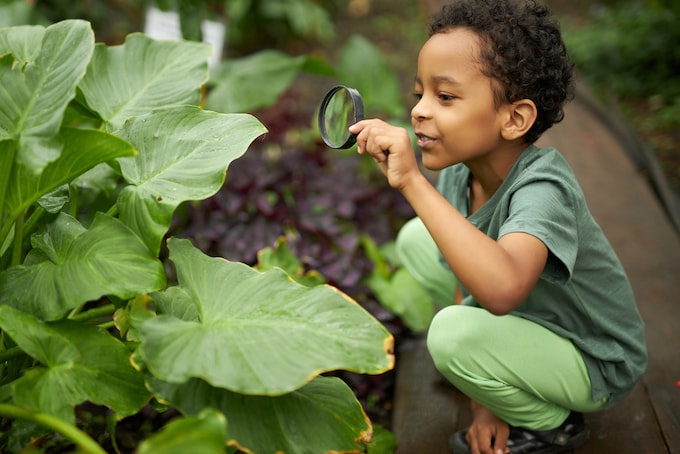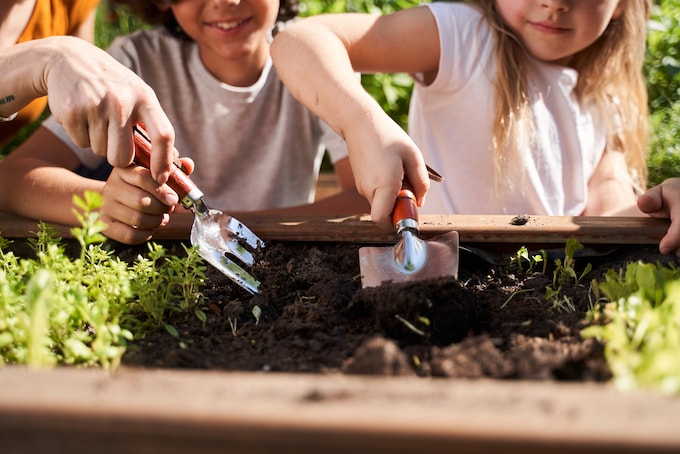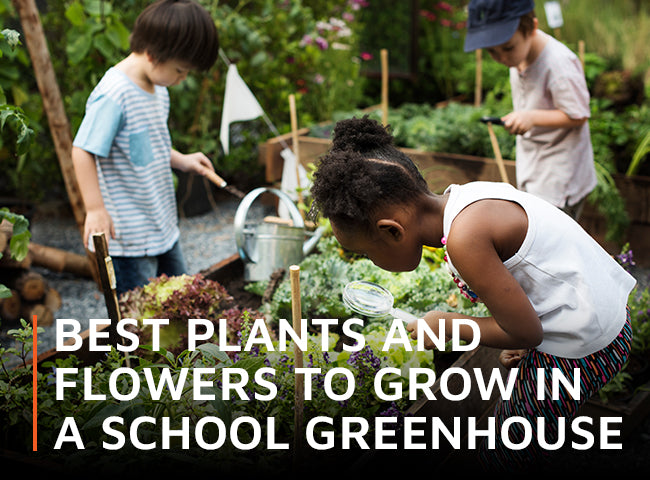Growing flowers and plants in a school greenhouse is a rewarding project. Raising brightly coloured flowers from seed really captures children’s imaginations and gets them interested in nature like nothing else can. When the plants are big enough, you can use them for all sorts of extension work like drawing, science lessons, or even as a young enterprise initiative by selling them at fetes and sports days. Here are some of the best plants and flowers to sow and grow in your school greenhouse.
Why you should grow plants and flowers in a school greenhouse

Image: Roman Chazov/Shutterstock
Growing plants and flowers in a greenhouse speeds up the process, making it more likely that you’ll see results in term time. Apart from learning about sowing and growing, here are more of the ways you can use your plants and flowers in lessons:
- Arts and crafts. Use plants with clearly lobed leaves, like ferns or Achillea, for colour printing with paint. Place flowers in vases for sketching, and experiment with drying flowers and seed heads. They have lovely forms and can be sprayed gold for Christmas decorations.
- Science drawings. Use plants with large flowers, like nasturtiums or daisies, to draw in lessons. Children can label their drawings to learn the parts.
- Biology. Sunflowers have huge open flowers that are perfect for seed collecting. Sweet pea seeds are large enough to watch germination happen in a test tube.
- Sensory. Draw kids in with sweet scents and soft touch leaves. Grow these plants somewhere accessible, in waist-high containers or low hanging baskets. Sensory plants may engage children who find concentration or indoor learning challenging.
- Horticulture. Grow evergreen and deciduous plants, and a variety of common plants to help children learn their names.
- Raising funds. Selling plants at the summer fayre is a great way to make money to buy seeds for next year and introduces practical maths challenges.
- Attracting members. Use plants and flowers to decorate school grounds and foster a sense of ownership. It’s also a great way of attracting attention and recruiting new gardening club members!
Best plants and flowers to grow before the summer holidays

Image: Juice Flair/Shutterstock
These seeds are perfect for starting in the school greenhouse in early spring. Flowering in summer, use them to plant up outdoor containers or sell them at the school fayre:
- Nasturtiums. Some nasturtiums trail for more than 1m! They’re great for growing in hanging baskets or rambling across beds. The seeds germinate easily, and are a good way to introduce colour to the greenhouse. The flowers are edible too.
- Tagetes and calendula (marigolds). Sow seeds in early spring for bright golden flowers. Pollinators love these eye-catching flowers too.
- Ox-eye daisy. These familiar wildflowers are vigorous and easy to grow. Sow the seeds in the greenhouse in February to get flowers before the summer holidays.
- Morning glory. ‘Heavenly Blue’ is a classic variety with sky-blue trumpets and an easy nature. As a climber it works its way up trellis or bamboo poles inside the greenhouse, or spreads across beds and borders.
- Lamb’s ears. Just like its common name, the leaves of Stachys byzantina are as soft as fluffy lamb's ears. Sow the seeds in February and plant them somewhere kids can easily touch.
- Pelargoniums. Make sure you get pelargonium seeds (not hardy geraniums) for their scented soft leaves and bright flower colours. Sow them in the greenhouse in January or February.
- Herbs. Annual herbs, like basil, are easy to grow from seed and you should get a couple of repeat harvests before the summer holidays start. Sow them in February, and keep them in the greenhouse until the plants flower in midsummer.
Best plants and flowers to grow after the summer holidays

Image: Olena Yakobchuk/Shutterstock)
If you can’t organise monitors to come in and water your greenhouse plants over the summer holidays, send them home with families to look after during the break. Many perennials, like ox-eye daisies, will flower into early autumn if they’re watered through summer. And when you return to school for the autumn term, here are the best plants and flowers to grow from September onwards:
- Spring flowering bulbs. Plant these around school in September and October. Daffodils are cheap, cheerful and easy to get hold of.
- Sweet peas. Sow sweet pea seeds in autumn to overwinter in the greenhouse. These plants will flower earlier than those sown in the spring. Support your sweet peas with canes or pea sticks when you move them to their final position.
- Perennial herbs. Autumn is the best time to take cuttings of perennial herbs like mint, lavender, lemon balm and rosemary. Root these in pots in the greenhouse for potting on in spring.
- Bay. This vigorous evergreen shrub has lovely sweet-scented leaves. It's easy to grow from a cutting, so ask a parent for a sprig to root, or buy a small plant. Grow your bay in a large container outside the greenhouse.
- Cyclamen. Plant cyclamen after the summer holidays in the greenhouse. The corms develop leaves in autumn and flower during the winter months. This could be a fun project for gardening club members to take home in the winter holidays. They could also be sold at a Christmas fayre.
We hope this has given you plenty of ideas for plants and flowers to grow at school. Want to grow food with your gardening club? Read our article on fruit and veg to grow in a school greenhouse. Please drop us a line via blog@waltons.co.uk or tag us using #MyWaltons at Twitter or Instagram. We’d love to see what you grow!
Lead image: Robert Kneschke/Shutterstock




